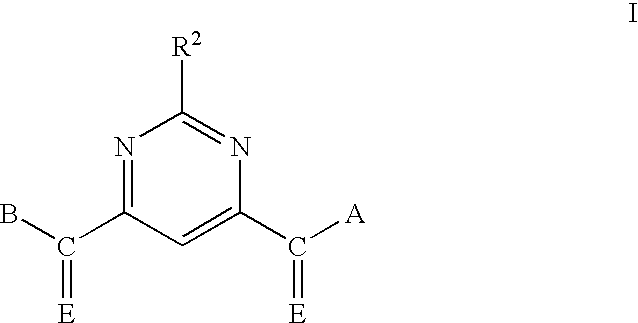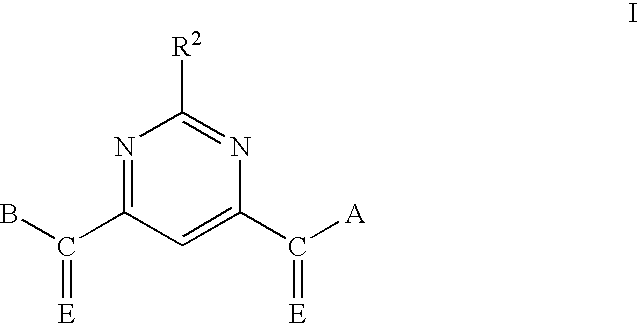Pyrimidine matrix metalloproteinase inhibitors
- Summary
- Abstract
- Description
- Claims
- Application Information
AI Technical Summary
Benefits of technology
Problems solved by technology
Method used
Image
Examples
example 1
Pyrimidine-4,6-dicarboxylic Acid, Bis-benzylamide
[0126]Pyrimidine-4,6-dicarboxylic acid is dissolved in dichloromethane (DCM) at 24° C. To the solution is added three equivalents of thionyl chloride. The reaction mixture is stirred at 24° C. for 1 hour. The reaction mixture is concentrated by evaporation of the solvent under reduced pressure to give an oil. The oil is dissolved in ethyl acetate, and three equivalents of benzylamine are added. The reaction mixture is stirred at 24° C. for 3 hours. The solvent is than removed by evaporation under reduced pressure to give an oil. The oil is purified by chromatography over silica gel, eluting with hexane-ethyl acetate (9:1) to 100% ethyl acetate. The fractions shown by thin layer chromatography to contain a single product component are combined and concentrated to dryness under reduced pressure to give the title compound.
example 2
Combinatorial Synthesis Method
Loading of the Resin is Carried Out as Follows
[0127]Marshall resin (15.2 g, 21.25 mmol) is swollen in DCM (300 mL) in a 500-mL resin tube (CAUTION: Slightly exothermic, the DCM may boil), and the mixture is allowed to cool. Once the mixture is cooled, the tube is capped and agitated slowly for 5 minutes, venting frequently. The DCM is drained to waste. The DCM wash is repeated two additional times, then the resin is resuspended in DCM (300 mL), and triethylamine (TEA, 3.2 g, 32 mmol, 1.5 mol. eq.) is added slowly. The resulting mixture is swirled for 5 minutes, and pyrimidine-4,6-dicarboxylic acid dichloride (17.2 g, 85 mmol, 4 eq) is added in one portion. The resin tube is capped, carefully secured in a wrist shaker, and inverted for 36 hours.
[0128]After 36 hours, a slight darkening of the resin may be noted. The reaction solvent is drained, and the residual resin is washed three times with DCM (200 mL) and two times with diethyl ether (200 mL). The re...
composition example 1
[0155]
Tablet Formulation IngredientAmount (mg / tablet)Compound of Example 125Lactose50Cornstarch (for mix)10Cornstarch (paste)10Magnesium stearate (1%)5Total100
[0156]The compound of Example 1, lactose, and cornstarch (for mix) are blended to uniformity. The cornstarch (for paste) is suspended in 200 mL of water and heated with stirring to form a paste. The paste is used to granulate the mixed powders. The wet granules are passed through a No. 8 hand screen and dried at 80° C. The dry granules are lubricated with the 1% magnesium stearate and pressed into a tablet. Such tablets can be administered to a human from one to four times a day for treatment of atherosclerosis and arthritis.
PUM
| Property | Measurement | Unit |
|---|---|---|
| Selectivity | aaaaa | aaaaa |
Abstract
Description
Claims
Application Information
 Login to View More
Login to View More - R&D Engineer
- R&D Manager
- IP Professional
- Industry Leading Data Capabilities
- Powerful AI technology
- Patent DNA Extraction
Browse by: Latest US Patents, China's latest patents, Technical Efficacy Thesaurus, Application Domain, Technology Topic, Popular Technical Reports.
© 2024 PatSnap. All rights reserved.Legal|Privacy policy|Modern Slavery Act Transparency Statement|Sitemap|About US| Contact US: help@patsnap.com










